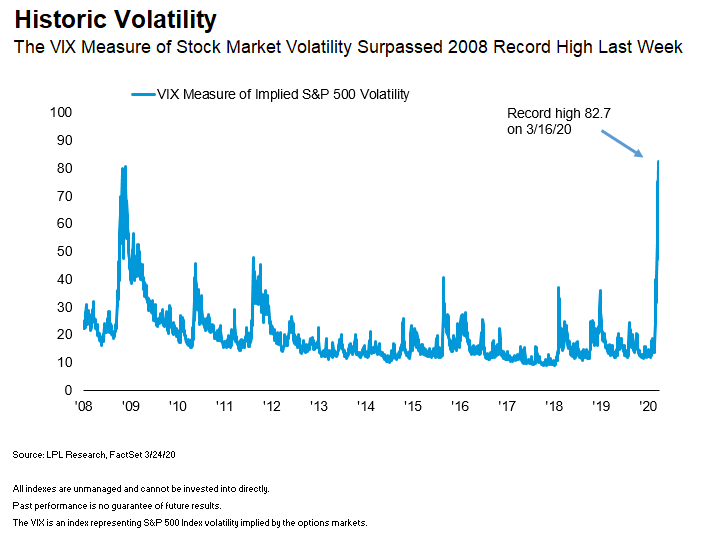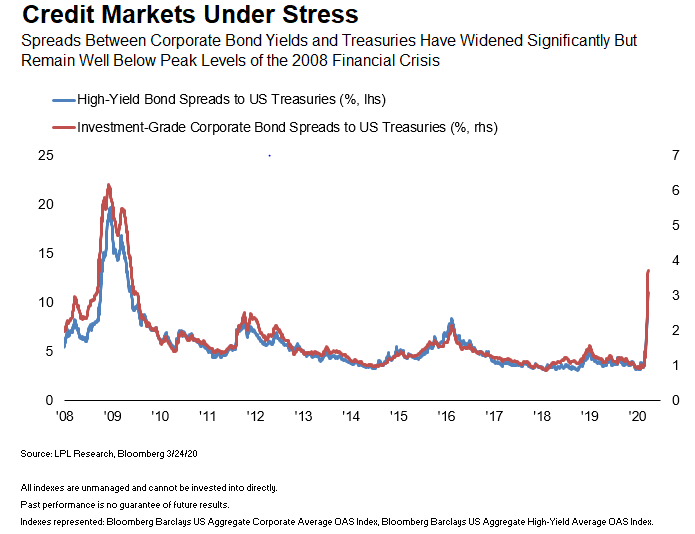The COVID-19 pandemic has caused unprecedented volatility in recent weeks that has investors and traders scrambling to assess the economic and market impact of the aggressive containment measures.
This past week the CBOE Volatility Index (VIX), which measures the implied 30-day volatility of the S&P 500 Index based on options contracts, measured its highest reading since its inception at over 82—besting the prior high set during the financial crisis in 2008-2009, shown in the chart below. That is saying something.
As market participants have sought shelter from the storm in traditional safe havens such as US Treasuries, gold, or cash, we have seen signs that liquidity has dried up. All that means is buyers have become more tentative, demanding lower prices to get trades done due to the historic volatility and heightened uncertainty. That in turn can lead to wider bid-ask spreads for market participants—both retail investors and institutions—and we sometimes see a dollar of value selling for 95 cents, if not less.
We have seen some of this in the corporate bond markets in recent days. Even short-maturity, high-quality investment grade corporate bond strategies have seen market prices disconnect with their fair value, as measured by net asset value (NAV). That metric essentially adds up the value of individual bonds in a portfolio such as an exchange-traded fund, which should in theory match the market price of the security that we all see on our screens.
“In volatile markets, quality items go on sale to clear the racks because there aren’t a lot of shoppers walking through the malls,” noted Ryan Detrick, LPL Financial Senior Market Strategist. “Improving liquidity in all markets can help restore investor confidence after being shaken the past few weeks.”
At their worst, these conditions can translate into serious dislocations, such as those experienced during the financial crisis when banks didn’t trust each other enough to make overnight loans and credit froze up. Short-term lending is a necessary lubricant for economic activity.
Investors can get hurt selling into these dislocated markets. This is where the Federal Reserve (Fed) comes in. The programs the Fed launched on Monday, March 23—including buying large amounts of corporate bonds—are aimed at restoring health to credit markets. The central bank’s aggressive bond purchases (as much as needed) should help restore orderly trading in corporate bonds and narrow spreads, a measure of risk, which have widened significantly in recent weeks. As shown in the chart below, spreads are still well short of 2008-2009 highs.
There is some other good news here. These dislocations can present opportunities for buyers to get discounts they may not otherwise see in normally functioning market environments. We aren’t suggesting running out and buying securities trading at the biggest discounts to their intrinsic value. Instead, we are highlighting that attractive opportunities are emerging in the corporate bond market, particularly in strategies focused on strong companies that may emerge on the other side of this crisis as leaders of the economic rebound.
Be well. Contact me if you have any questions or concerns. I am always right here.
Next Step: Speak to a Financial Advisor
IMPORTANT DISCLOSURES
This material is for general information only and is not intended to provide specific advice or recommendations for any individual. There is no assurance that the views or strategies discussed are suitable for all investors or will yield positive outcomes. Investing involves risks including possible loss of principal. Any economic forecasts set forth may not develop as predicted and are subject to change.
References to markets, asset classes, and sectors are generally regarding the corresponding market index. Indexes are unmanaged statistical composites and cannot be invested into directly. Index performance is not indicative of the performance of any investment and do not reflect fees, expenses, or sales charges. All performance referenced is historical and is no guarantee of future results.
Any company names noted herein are for educational purposes only and not an indication of trading intent or a solicitation of their products or services. LPL Financial doesn’t provide research on individual equities. All information is believed to be from reliable sources; however, LPL Financial makes no representation as to its completeness or accuracy.
This Research material was prepared by LPL Financial, LLC.
Securities and advisory services offered through LPL Financial (LPL), a registered investment advisor and broker-dealer (member FINRA/SIPC).
Insurance products are offered through LPL or its licensed affiliates. To the extent you are receiving investment advice from a separately registered independent investment advisor that is not an LPL affiliate, please note LPL makes no representation with respect to such entity.
If your representative is located at a bank or credit union, please note that the bank/credit union is not registered as a broker-dealer or investment advisor. Registered representatives of LPL may also be employees of the bank/credit union.
These products and services are being offered through LPL or its affiliates, which are separate entities from, and not affiliates of, the bank/credit union. Securities and insurance offered through LPL or its affiliates are:
- Not Insured by FDIC/NCUA or Any Other Government Agency
- Not Bank/Credit Union Guaranteed
- Not Bank/Credit Union Deposits or Obligations
- May Lose Value
For Public Use | Tracking # 1-971339


